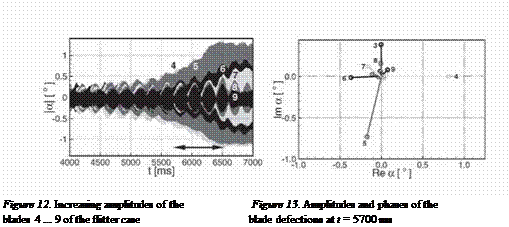Flutter Measurements
Increasing the vibration amplitude beyond a certain level in the "flutter case" the cascade starts with self-excited vibrations. Figure 12 plots the amplitude
of some blades versus time when the cascade was excited at a frequency of 177 Hz. After reaching a certain amplitude, the cascade start to vibrate at its eigenfrequency of 182 Hz. Then the excitation was turned down. While the cascade was vibrating in its eigenfrequency and was simultaneously excited, beats are clearly visible. A Fourier analysis performed every 100 ms

for sections of 819 ms (8192 time samples) leads to the complex amplitudes (amplitude and phase) and gives an insight into the vibration mode. (Figure 13 shows the results of a Fourier analysis started at 5700 ms.)
It is visible, that only some blades — namely blade 3 to 9 — were vibrating with a significant amplitude. The phase between these blades remained constant over time, but there is no equal interblade phase angle between all blades visible. This may be caused by the cascades’s mistuning due to blades equiped with pressure taps and tubes as well as blades with unsteady pressure transducers.
2. Summary
Measurements of aerodynamic damping were performed for nearly identical transonic fbw cases, but for different reduced frequencies. For the lower reduced frequency the cascade was proven to be aerodynamically unstable. Besides the front shock impulse and pressure side’s channel shock impulse this unstable case was characterized by a strong channel shock impulse near suction side’s trailing edge. While the effects of the front shock impulse and pressure side’s channel shock impulse canceled out each other, the impulse of the channel shock near the trailing edge on the suction side had a significant inflience on stability. Increasing the forced vibration amplitude, the cascade started with self-excited vibrations.











